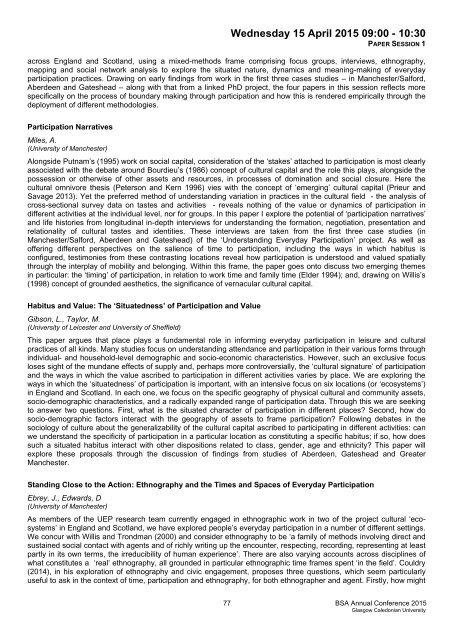Programme full
Programme full
Programme full
Create successful ePaper yourself
Turn your PDF publications into a flip-book with our unique Google optimized e-Paper software.
Wednesday 15 April 2015 09:00 - 10:30<br />
PAPER SESSION 1<br />
across England and Scotland, using a mixed-methods frame comprising focus groups, interviews, ethnography,<br />
mapping and social network analysis to explore the situated nature, dynamics and meaning-making of everyday<br />
participation practices. Drawing on early findings from work in the first three cases studies – in Manchester/Salford,<br />
Aberdeen and Gateshead – along with that from a linked PhD project, the four papers in this session reflects more<br />
specifically on the process of boundary making through participation and how this is rendered empirically through the<br />
deployment of different methodologies.<br />
Participation Narratives<br />
Miles, A.<br />
(University of Manchester)<br />
Alongside Putnam’s (1995) work on social capital, consideration of the ‘stakes’ attached to participation is most clearly<br />
associated with the debate around Bourdieu’s (1986) concept of cultural capital and the role this plays, alongside the<br />
possession or otherwise of other assets and resources, in processes of domination and social closure. Here the<br />
cultural omnivore thesis (Peterson and Kern 1996) vies with the concept of ‘emerging’ cultural capital (Prieur and<br />
Savage 2013). Yet the preferred method of understanding variation in practices in the cultural field - the analysis of<br />
cross-sectional survey data on tastes and activities - reveals nothing of the value or dynamics of participation in<br />
different activities at the individual level, nor for groups. In this paper I explore the potential of ‘participation narratives’<br />
and life histories from longitudinal in-depth interviews for understanding the formation, negotiation, presentation and<br />
relationality of cultural tastes and identities. These interviews are taken from the first three case studies (in<br />
Manchester/Salford, Aberdeen and Gateshead) of the ‘Understanding Everyday Participation’ project. As well as<br />
offering different perspectives on the salience of time to participation, including the ways in which habitus is<br />
configured, testimonies from these contrasting locations reveal how participation is understood and valued spatially<br />
through the interplay of mobility and belonging. Within this frame, the paper goes onto discuss two emerging themes<br />
in particular: the ‘timing’ of participation, in relation to work time and family time (Elder 1994); and, drawing on Willis’s<br />
(1998) concept of grounded aesthetics, the significance of vernacular cultural capital.<br />
Habitus and Value: The ‘Situatedness’ of Participation and Value<br />
Gibson, L., Taylor, M.<br />
(University of Leicester and University of Sheffield)<br />
This paper argues that place plays a fundamental role in informing everyday participation in leisure and cultural<br />
practices of all kinds. Many studies focus on understanding attendance and participation in their various forms through<br />
individual- and household-level demographic and socio-economic characteristics. However, such an exclusive focus<br />
loses sight of the mundane effects of supply and, perhaps more controversially, the ‘cultural signature’ of participation<br />
and the ways in which the value ascribed to participation in different activities varies by place. We are exploring the<br />
ways in which the ‘situatedness’ of participation is important, with an intensive focus on six locations (or ‘ecosystems’)<br />
in England and Scotland. In each one, we focus on the specific geography of physical cultural and community assets,<br />
socio-demographic characteristics, and a radically expanded range of participation data. Through this we are seeking<br />
to answer two questions. First, what is the situated character of participation in different places? Second, how do<br />
socio-demographic factors interact with the geography of assets to frame participation? Following debates in the<br />
sociology of culture about the generalizability of the cultural capital ascribed to participating in different activities: can<br />
we understand the specificity of participation in a particular location as constituting a specific habitus; if so, how does<br />
such a situated habitus interact with other dispositions related to class, gender, age and ethnicity? This paper will<br />
explore these proposals through the discussion of findings from studies of Aberdeen, Gateshead and Greater<br />
Manchester.<br />
Standing Close to the Action: Ethnography and the Times and Spaces of Everyday Participation<br />
Ebrey, J., Edwards, D<br />
(University of Manchester)<br />
As members of the UEP research team currently engaged in ethnographic work in two of the project cultural ‘ecosystems’<br />
in England and Scotland, we have explored people’s everyday participation in a number of different settings.<br />
We concur with Willis and Trondman (2000) and consider ethnography to be ‘a family of methods involving direct and<br />
sustained social contact with agents and of richly writing up the encounter, respecting, recording, representing at least<br />
partly in its own terms, the irreducibility of human experience’. There are also varying accounts across disciplines of<br />
what constitutes a ‘real’ ethnography, all grounded in particular ethnographic time frames spent ‘in the field’. Couldry<br />
(2014), in his exploration of ethnography and civic engagement, proposes three questions, which seem particularly<br />
useful to ask in the context of time, participation and ethnography, for both ethnographer and agent. Firstly, how might<br />
77 BSA Annual Conference 2015<br />
Glasgow Caledonian University


